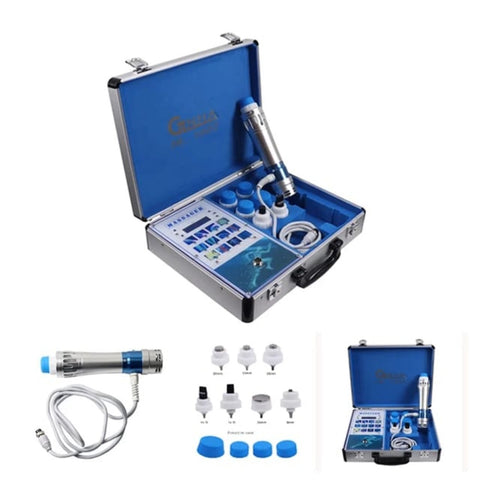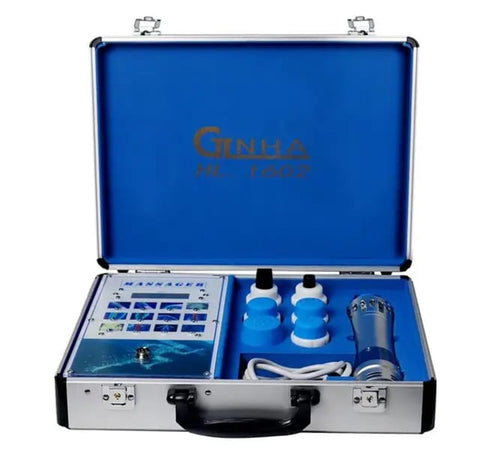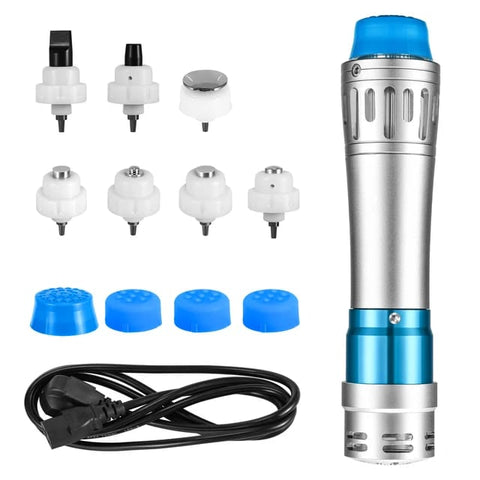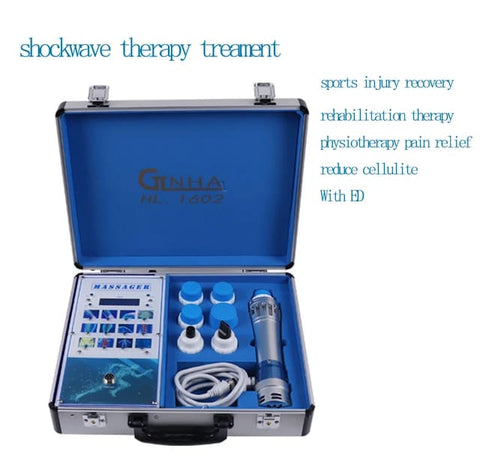Biotronix Multi-Head ESWT Shockwave Device for Precision Pain Management in Physiotherapy with 1 Year Warranty
Biotronix Multi-Head ESWT Shockwave Device for Precision Pain Management in Physiotherapy with 1 Year Warranty
Features :-
1. The human engineering design provides setting and operates conveniently.
2. Import power source, to ensure instant shock output effect.
3. Surge pressure and frequency selection, conform to treatment demand.
4. The ultra-silence air compressor is built-in accessories collection box.
5. Provides a various professional probe.
6. High effectiveness, fast relieve pain.
7. No need for surgery, the cure rate of 80~90%
8. Noninvasive, no anesthetic, convenient and fast.
9. Widely applied to different soft tissue treatments.
10. This machine could be used to treat joints pain and ED treatment.
Parameter Product Name: Shock wave machine
* Color: Silver + blue
* Voltage:AC110V-AC220V
* Frequency:50HZ/60HZ
* Power:90W
* MAX Current:2A
* MAX Output frequency numbers:16
* Output level numbers:12
* Transmitters numbers:7pcs
Extracorporeal body massager shock wave therapy machine pain relief massager Pain Relief Massager Relaxation Pain Relief Application: 1. Shoulder pain, calcific tendonitis 2. Radial or ulnar humeral epicondylitis 3. Trochanteric tendonitis 4. Waist or stern pain 5. Patellar tendonitis 6. Tibial stress syndrome 7. Achillodynia 8. Plantar fascitis 9. ED Treatment.



















WHAT IS SHOCKWAVE THERAPY?
The shockwaves work by stimulating the affected tissue at a cellular level, encouraging the production of collagen, which is essential for tissue repair. Additionally, the therapy helps to break down scar tissue and calcifications, both of which can contribute to pain and hinder proper movement. Although some discomfort may occur during treatment, most people tolerate the procedure well, and any mild soreness usually subsides within a day or two. Many patients report significant improvements in pain relief and mobility following treatment, especially when other therapies have been ineffective.
BENEFITS OF SHOCKWAVE THERAPY.
Shock wave therapy has many biological benefits including :-
* Improves muscle elasticity: Increases the flexibility and stretch capacity of muscles, reducing the risk of strains.
* Enhances soft tissue mobility: Breaks down tough fibrous tissue, improving the smooth movement of soft tissues.
* Supports long-term pain management: Provides sustained pain relief, reducing the need for ongoing treatments.
* Boosts mechanical strength of tissues: Strengthens tendons, ligaments, and muscles, making them more resistant to future injuries.
* Promotes anti-inflammatory effects: Reduces inflammation in the affected area, contributing to faster recovery and pain reduction.
* Improves postural alignment: Helps alleviate pain caused by musculoskeletal imbalances, improving overall posture.
* Restores tendon elasticity: Helps restore the natural elasticity of tendons that may have become stiff or damaged.
* Assists with injury prevention: By improving tissue resilience and flexibility, it lowers the risk of injury in athletic activities.
* Increases the effectiveness of physical therapy: When combined with other rehabilitation techniques, it enhances the overall treatment outcomes.
PRINCIPLES OF SHOCKWAVE THERAPY.
- Electrohydraulic Generation Principle
· Piezoelectric Generation Principle
· Electromagnetic Generation Principle
· Radial or Ballistic Generation Principle
Four generating principles in the field of shock waves are Electrohydraulic, Electromagnetic sources, and Piezoelectric sources, and the Radial or Ballistic Generation Principles. The shock wave emitted by most of the equipment's have a focal zone that is several centimeters ahead of the generator. The therapeutic effects occur where most sonic waves are gathered in the focal zone, so this is often the action spot. The shock wave is transmitted through the coupling medium into the tissue creating a focal zone. It is necessary to make sure that the target area is in the focal zone during the shock wave treatment.
WHAT ARE THE TREATMENT PARAMETERS?
Parameters include acoustic energy, energy flux density (EFD), pressure distribution and the total energy at the second focal point. The energy flux density (EFD) of the focused shock wave used for the treatment of muscular trigger point is between 0.05 and 0.25 mJ/mm2. To avoid tissue damage the shock wave frequency applied to the trigger point should not exceed 4 Hz. Based on the thickness and depth of the muscle, the energy flux density (mJ/mm2) is selected. The energy flux density should be selected in such a way that the pain induced by the shock waves is tolerable for the patient. For the radial shock waves, the same method applies. Extreme caution should be taken while using small surface shock transmitters with a small surface as they generate high peak pressures, to avoid hematomas. The shock wave frequency is 10 to 15 Hz, 15 Hz frequency generally causes less pain. When using a combination of focused and radial shock waves in trigger point therapy, the trigger points are first treated by applying 200 to 400 focused shock waves. It is then followed by the radial shock wave transmitter, applying 3000 to 4000 radial shock waves.
Frequency: It is ideal to give one session per week for most patients. These intervals give muscles time to recover from the irritation, which the patient might feel for up to three days.
HOW DOES SHOCK THERAPY WORK?
Shockwave therapy has a positive and negative phase. The positive phase produces direct mechanical forces, whereas the negative phase generates cavitations and gas bubbles that subsequently implode at high speeds, generating a second wave of shockwaves. It uses high peak pressure followed by low amplitude, short duration, and short rise time. They have a single pulse, with high-pressure amplitude (0-120 MPa) and a wide frequency range (0-20 MHz). Whereas ultrasound waves have approximately 1000 times lesser peak pressure than that of a shockwave. Shockwaves are low-frequency pressure disturbances that travel rapidly in three-dimensional space, associated with a sudden rise from ambient pressure to their maximum pressure. Significant tissue effects include cavitations, which are consequent to the negative phase of the wave propagation.
The whole process does not produce any thermal effect, it promotes revascularization, stimulating proliferation and osteoprogenitor differentiation, increases leukocyte infiltration, amplifies growth factor and protein synthesis to stimulate collagen synthesis and tissue remodeling.
APPLICATION
The patient is assessed by the physiotherapist during his first visit to confirm that he is an appropriate candidate for shockwave therapy. The treatment is started by applying gel on the treatment area. The applicator or therapy head is directly placed on the area. A medium of gel is required for the transmission of the waves through the patient's skin. The parameters are set and the intensity is applied according to the comfort of the patient (there is no standardized protocol for the treatment of musculoskeletal conditions). It can be used in conjunction with treatment-specific exercises, activity modification. Depending on the results, the patient is advised to take the shockwave therapy once a week for 3-6 weeks.
CONDITIONS TREATED BY SHOCKWAVE THERAPY.
Shockwave therapy is most commonly used in the treatment of common musculoskeletal conditions. These include:
- Acute and chronic muscular pain in cervical and lumbar spine regions.
- Chronic tendinopathy
- Calcific tendinosis of rotator cuff muscles
- Frozen shoulder
- Dorsalgia
- Tennis elbow
- Golfers elbow
- Carpal tunnel syndrome
- Sciatic pain
- Tensor fascia late syndrome
- Iliotibial band friction syndrome
- Greater trochanteric pain syndrome
- Avascular necrosis of the femoral head
- Medial tibial stress syndrome
- Osteoarthritis of knee
- Patellar tendonitis
- Jumper's knee
- Bursitis
- Metarsalgia
- Tibialis anterior syndrome
- Achilles tendonitis
- Plantar fasciitis
- Heel spurs
- Fracture
- Exostosis of small joints
- Repetitive strain and overuse injuries.
SIDE EFFECTS OF SHOCKWAVE THERAPY.
The patient experiences temporary tenderness, soreness, or swelling for few days after the treatment shockwaves stimulate an inflammatory response. The patient return to the regular activities immediately after the completion of the treatment.
CONTRAINDICATIONS FOR SHOCKWAVE THERAPY.
- Pacemakers
- Implanted devices
- Joint replacements
- Pregnancy
- Tumor
- Infection
- Open wounds
- Circulation or nerve disorder.
SEO Keywords :-
Shockwave therapy for enhanced injury recovery, GINHA HL1602 shockwave machine for muscle rehabilitation, Shockwave therapy for reducing muscle knots and tightness, ESWT shockwave device for faster healing of joint pain, Shockwave therapy machine for treating fibromyalgia pain, Shockwave therapy for non-invasive treatment of tendon injuries, Shockwave machine for alleviating chronic lower back pain, Shockwave therapy for improving flexibility in injured tissues, Shockwave therapy for accelerating recovery in soft tissue damage, GINHA HL1602 shockwave for effective recovery from athletic injuries, Shockwave therapy for breaking down scar tissue and adhesions, Shockwave device for treating calcified tendons and muscles, Shockwave therapy for improving post-injury mobility, ESWT shockwave therapy for relieving neck and shoulder pain, Shockwave machine for increasing blood flow to injured muscles, Shockwave therapy for reducing pain in inflammatory conditions, Shockwave therapy for treating stress fractures and bone injuries, Shockwave device for post-injury recovery and rehabilitation, Shockwave therapy for reducing swelling in injured areas.
SEO Tags :-
Shockwave therapy for non-invasive injury treatment, GINHA HL1602 shockwave for deep tissue therapy, ESWT shockwave machine for advanced pain relief, Shockwave therapy for faster healing of musculoskeletal injuries, Shockwave device for effective rehabilitation in physiotherapy, Shockwave therapy for reducing inflammation in joints, Shockwave machine for improving range of motion, Shockwave therapy for healing tendon tears and sprains, Shockwave device for sports injury recovery, Shockwave therapy for muscle regeneration and repair, ESWT shockwave for treating ligament strains, Shockwave therapy for easing chronic pain in soft tissues, Shockwave machine for effective post-injury recovery, Shockwave therapy for pain relief in orthopedic conditions, Shockwave device for treating deep muscle soreness, Shockwave therapy for treating plantar fasciitis and heel pain, Shockwave therapy for non-surgical treatment of joint pain, Shockwave machine for muscle stiffness and tightness relief, Shockwave therapy for enhancing recovery speed in athletes, Shockwave device for breaking down calcifications in tissues.

















































































